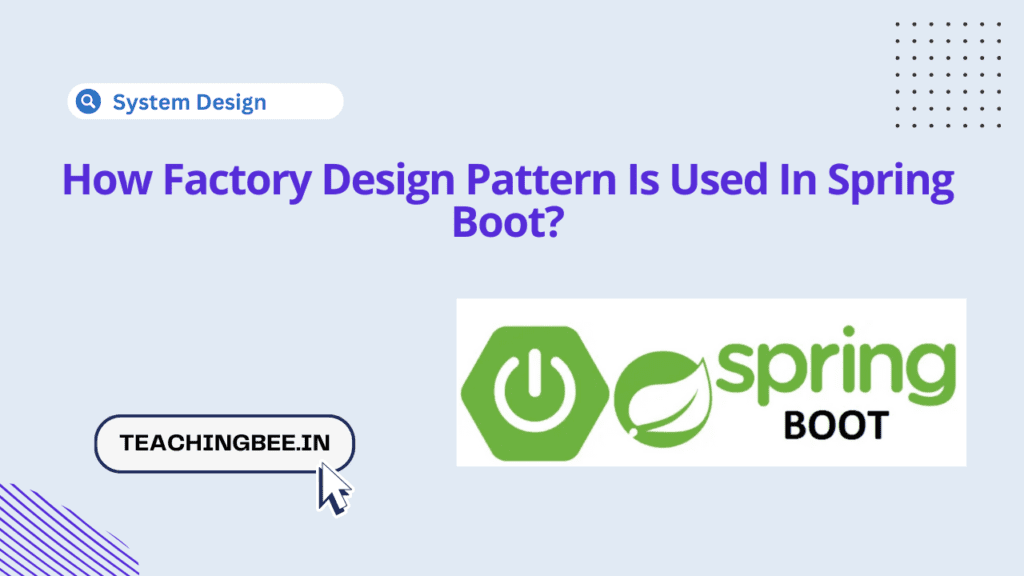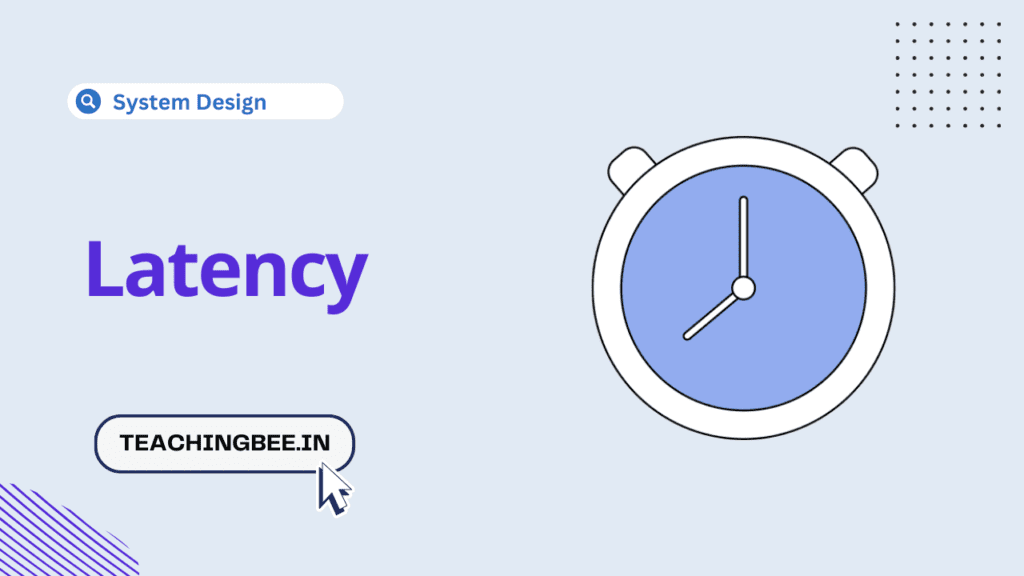Table of Contents
ToggleThe Factory Design Pattern offers a robust mechanism for object creation and configuration in Spring Boot applications. By encapsulating the instantiation logic within factory methods, Spring Boot promotes flexibility, scalability, and maintainability in application development.
Let’s explore in detail how Factory Design Pattern is utilised within the Spring Boot framework, accompanied by comprehensive Java code snippets.
Understanding how factory design pattern is used in Spring Boot?
Spring Boot, a popular framework for building microservices in Java, leverages the Factory Pattern in several ways to promote loose coupling and enhance flexibility.
1. Bean Creation with @Bean Annotation
In Spring Boot, you can define beans using the @Bean annotation inside a @Configuration class. This approach is similar to a factory method pattern where each method is responsible for producing an instance of a bean.
@Configuration
public class AppConfig {
@Bean
public MyService myService() {
return new MyServiceImpl();
}
}In this example, AppConfig acts as a factory class, and the myService method is a factory method that produces a MyService bean.
2. Implementing FactoryBean
The FactoryBean interface in Spring Framework offers a sophisticated way to implement the Factory Design Pattern, especially suited for scenarios where bean instantiation involves complex logic that goes beyond simple constructor calls. This interface is part of Spring’s core container and is designed for cases where a bean is not straightforward to create with the standard @Bean annotation or when the creation process requires more control and configurability.
Consider the following example:
public class ToolFactoryBean implements FactoryBean<Tool> {
private int factoryId;
private int toolId;
@Override
public Tool getObject() throws Exception {
return new Tool(toolId);
}
@Override
public Class<?> getObjectType() {
return Tool.class;
}
// standard setters and getters
}Here, ToolFactoryBean implements FactoryBean, providing a way to encapsulate complex initialization logic inside the getObject() method.
3. Auto-Configuration in Spring Boot
Auto-configuration classes in Spring Boot use conditional annotations to decide whether or not to instantiate beans. This is a form of the Factory Pattern, where the decision to create an object is based on the environment and context.
@Configuration
@ConditionalOnClass(DataSource.class)
public class DataSourceAutoConfiguration {
@Bean
@ConditionalOnMissingBean
public DataSource dataSource() {
return new HikariDataSource();
}
}In this snippet, DataSourceAutoConfiguration is a factory that only creates a DataSource bean if a bean of that type does not already exist and if the DataSource class is present in the classpath.
4. BeanFactory and ApplicationContext Usage
BeanFactory and ApplicationContext are both central components in the Spring Framework, responsible for managing beans (objects) and their dependencies. The BeanFactory is the core interface for accessing and managing beans, providing basic functionalities such as bean instantiation, wiring, and lifecycle management.
On the other hand, ApplicationContext extends the functionality of BeanFactory by providing features like internationalization, event propagation, and AOP integration. Understanding their roles is vital for configuring and utilizing dependency injection effectively within Spring applications, even though BeanFactory is typically not directly used for bean creation in application code due to the more feature-rich ApplicationContext.
Although not typically used directly for creating beans in application code, understanding how BeanFactory and ApplicationContext work as factories is crucial.
public class MyApp {
public static void main(String[] args) {
ApplicationContext ctx = new AnnotationConfigApplicationContext(AppConfig.class);
MyService myService = ctx.getBean(MyService.class);
// Use myService
}
}In this example, ApplicationContext is used as a factory to retrieve beans defined in AppConfig.
Advantages of Factory Design Pattern in Spring Boot:
- Loose Coupling: The use of factory patterns allows Spring Boot applications to be highly modular and loosely coupled.
- Ease of Testing: By abstracting the creation logic, it becomes easier to replace implementations for testing.
- Dynamic Configuration: The conditional creation of beans enables applications to adapt to different environments seamlessly.
These examples demonstrate the practical application of the Factory Design Pattern in Spring Boot, showcasing its flexibility and power in managing bean lifecycles and application configurations.
Conclusion
The Factory Design Pattern is integral to Spring Boot’s architecture, offering a flexible, modular approach to bean creation and configuration. It abstracts object creation, promoting loose coupling and enhancing testability. Spring Boot applies this pattern through annotations like @Bean and @Configuration, interfaces like FactoryBean, and auto-configuration mechanisms. This design pattern supports dynamic, conditional bean instantiation, aligning with modern software development’s demands for adaptability and maintainability. Understanding and utilizing the Factory Pattern in Spring Boot enables developers to build scalable, loosely coupled Java applications efficiently.
Similar Posts
How to Apply Factory Design Pattern for Payment System
Can We Use Factory Design Pattern in Dependency Injection?
What Is the Difference Between Factory and Abstract Factory Design Patterns?
When to Use Factory Design Pattern in Java?
FAQ
What is the main goal of the factory design pattern?
The main goal of the factory design pattern is to provide an interface for creating objects in a superclass, but allow subclasses to alter the type of objects that will be created. It promotes loose coupling by abstracting the object creation process from the client code.
What is factory design pattern with real time example?
A real-time example of the factory design pattern could be a software application that produces different types of documents, such as reports, spreadsheets, and presentations. Instead of having the client code directly instantiate each type of document (e.g., Report, Spreadsheet, Presentation), a DocumentFactory can be used. The DocumentFactory provides methods for creating different types of documents based on user input or other factors. This way, the client code only interacts with the factory to obtain instances of documents, without being concerned about their specific implementation details.
What are the types of factory pattern?
There are several variations of the factory pattern, including:
- Simple Factory: This is the most basic form of factory pattern where a factory class has methods for creating objects without exposing the instantiation logic to the client.
- Factory Method: In this pattern, a superclass provides an interface for creating objects, but allows subclasses to override the instantiation process to provide different implementations of the created objects.
- Abstract Factory: This pattern provides an interface for creating families of related or dependent objects without specifying their concrete classes. It defines a set of methods, each of which returns a different abstract product.
What is the benefit of factory pattern?
The benefits of using the factory pattern include:
- Encapsulation: It encapsulates the object creation process, hiding the implementation details of object creation from the client code.
- Flexibility: It allows for easy extension and modification of the object creation process, enabling the addition of new types of objects without modifying existing client code.
- Promotes Loose Coupling: It promotes loose coupling between the client code and the created objects, as the client code only interacts with the factory interface, not with the concrete classes directly.
- Centralized Control: It provides a centralized place (the factory) to manage the creation of objects, making it easier to maintain and refactor the code.




